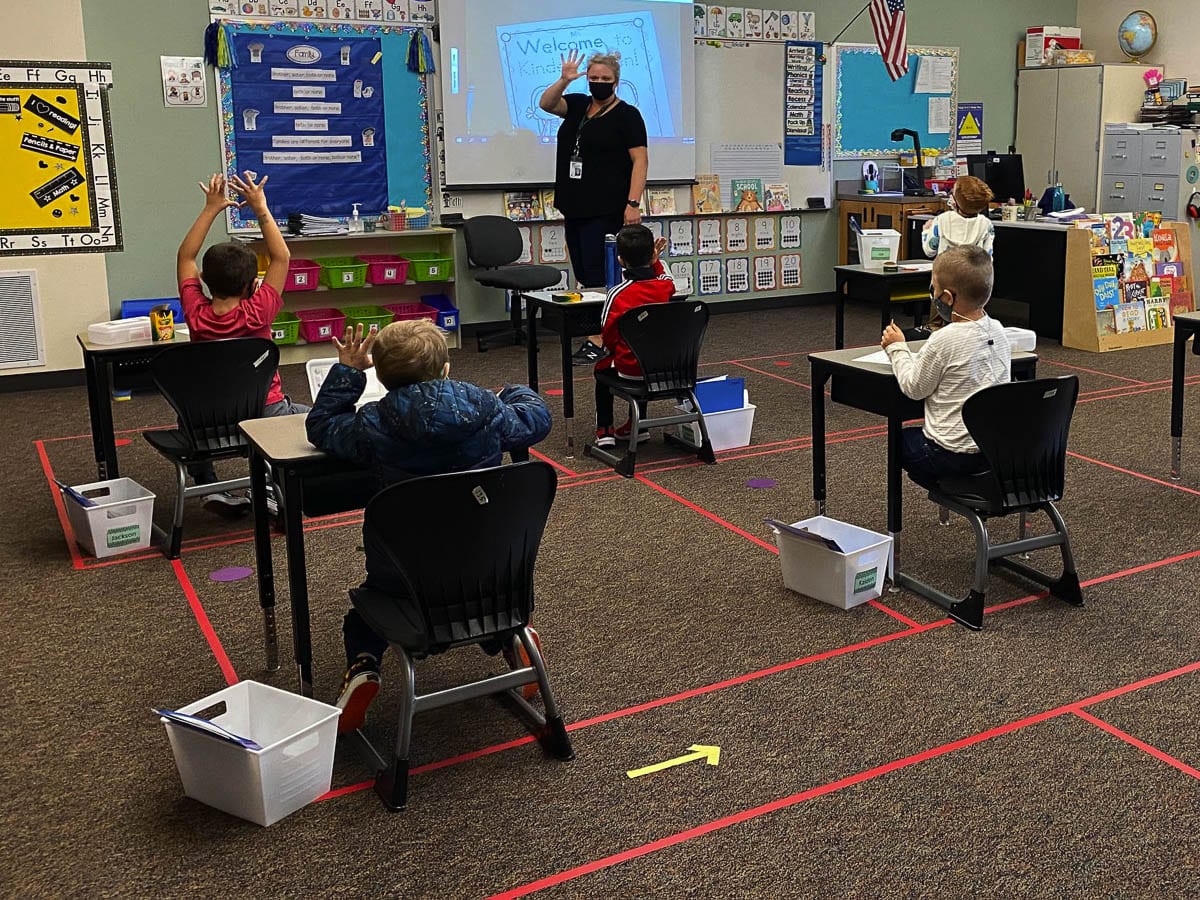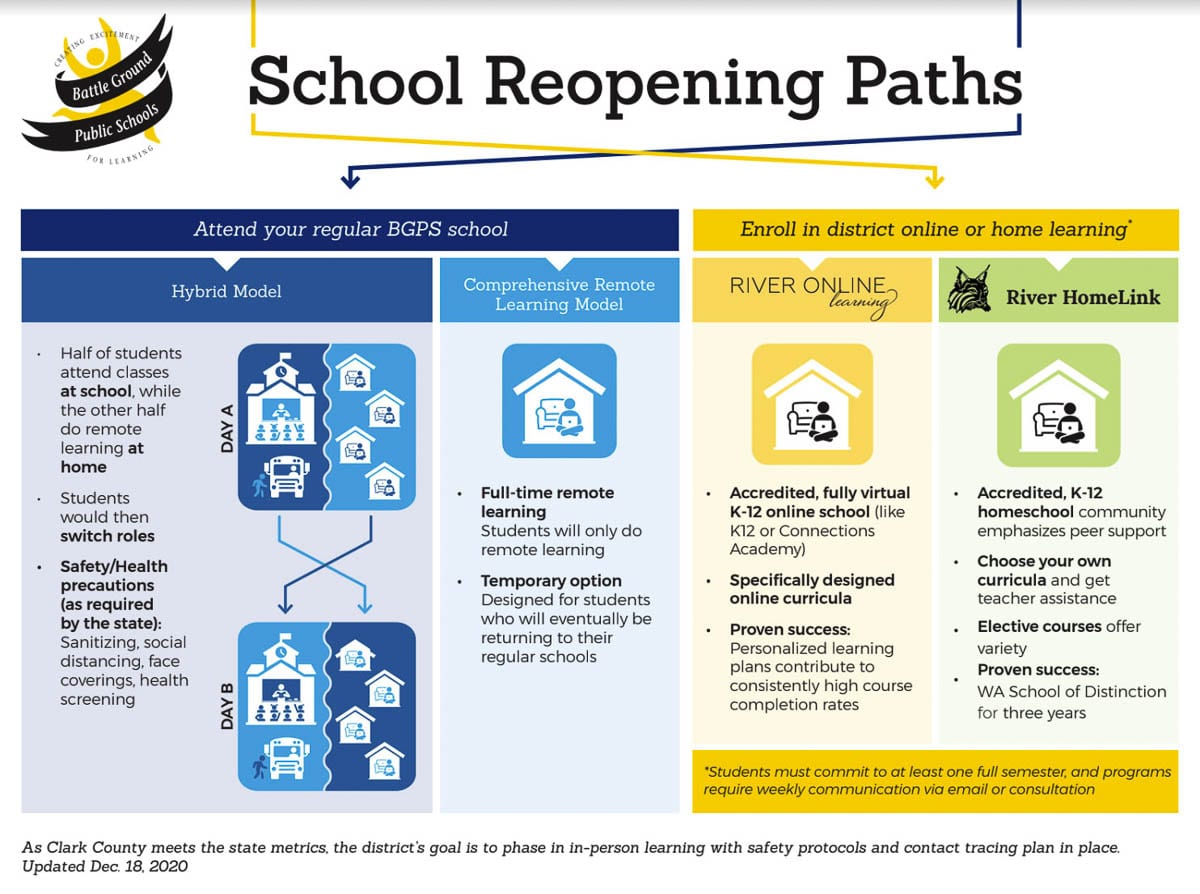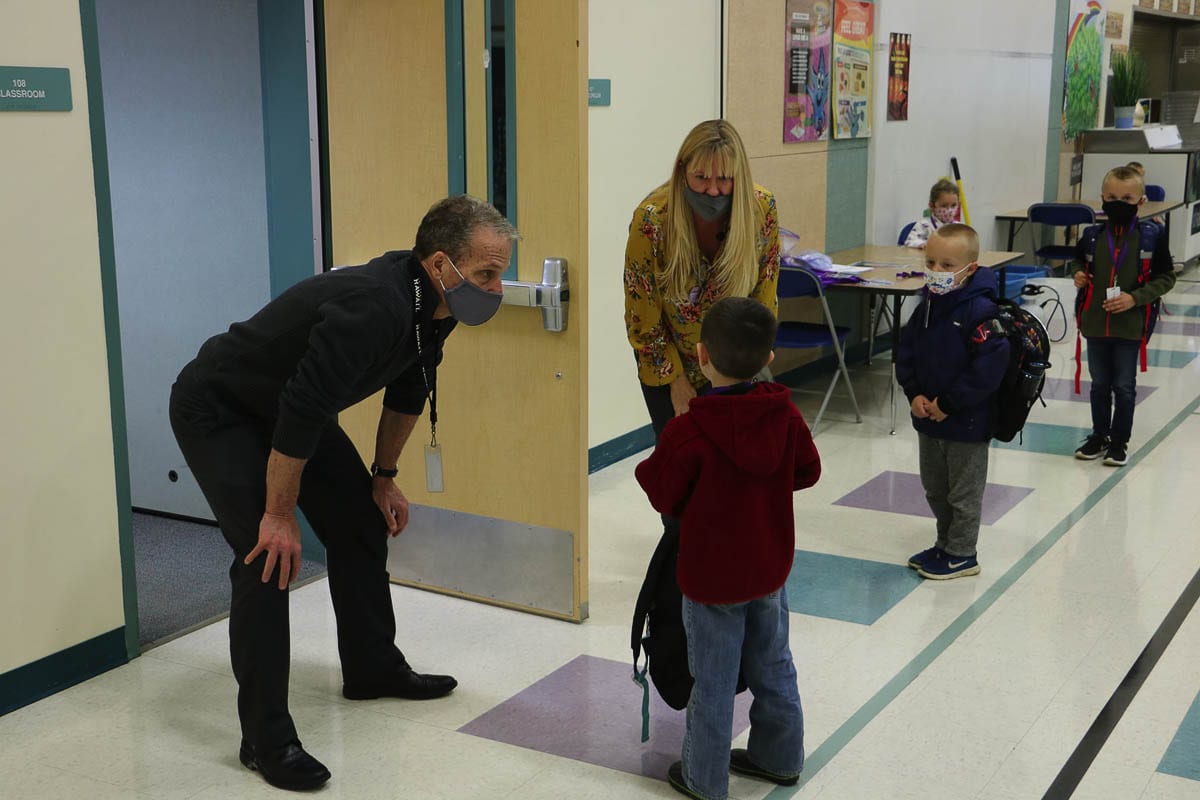Educators and superintendents continue to pressure the state to move up vaccinations for teachers
BATTLE GROUND — Starting Feb. 1, Battle Ground Public School students in grades K-4 will have the option of returning to their classroom two days a week, five hours a day, as the district expands in-person learning.
That decision has met with some pushback from educators.
In a resolution adopted by union leadership last week, the Battle Ground Education Association said it “strongly opposes further expansion of in-person instruction until all Battle Ground Public School District staff are provided access to all required COVID-19 vaccine doses.”

Contrary to rumors in some online groups, the resolution was not voted on by all teachers, only union building representatives, based on their conversations with educators. It is not binding, and does not represent a threat to strike, said BGEA President Fiona Engebretson.
“We want to do the best job that we can, as a union and as a district, to have language that addresses those safety needs as they change or are reflected in different requirements from the state,” Engebretson said in an interview with Clark County Today.
To that end, she said union leadership and district administrators are meeting nearly every day to finalize a third Memorandum of Understanding (MOU), aimed at addressing the concerns of teachers, while still enabling the district to expand in-person learning under the most recent guidelines from the Washington Department of Health and the Centers for Disease Control.
“I think that we are all working to the same end, and to provide education in as many ways as we possibly can,” said Engebretson. “And recognizing too, that there are different benefits and different drawbacks to in-person and teaching remotely at the same time.”
Battle Ground, like most school districts in the county, has had kindergarten students, special needs students, and other at-risk children using classrooms since November.

Nearly a dozen educators in the district spoke out during Monday’s meeting of the Battle Ground School Board, urging them to hold off on further expansion of in-person learning until after teachers have the chance to be vaccinated.
“It’s okay to pump the brakes when new information comes out,” said Becky Broyles, a teacher at River HomeLink in the district, “like a mutation or rising county numbers that are higher than they have ever been before.”
Others, like Jordan Osborne, a sixth grade teacher at Daybreak Middle School, said one student told an English as a Second Language teacher at the school he’d been to 14 sleepovers during the winter break.
“According to what students have told our teaching staff, anywhere between 50 to 75 percent of our ESL families attend church without masks on every week,” said Osborne. “They attend birthday parties and even funerals this way.”
While the district can work to enforce physical distancing, mask usage, and proper hygiene while in school, Osborne added, there is no way to control how students and their families behave outside of the classroom.
“These families are sending their students to the building because they can’t sustain their remote situation as is,” he told the board. “And this turns the school system and school teachers into babysitters in the process.”
That situation, worried Jeanne Vollmer, a speech pathologist in the district, could create a volatile and dangerous mixture.
“Knowing the deadly consequences of this mutating, highly contagious virus, why are you forcing adults into classrooms with children now?” Vollmer asked. “Why are you allowing young children to pick up and spread this disease to their parents and their grandparents?”
To date, Battle Ground Superintendent Mark Ross told the board there have been no known cases of student-to-teacher transmission of COVID-19 in the district, which has been serving kindergarten and special education students with in-person classes since early November.
“We know that we can do this safely,” Ross said, while adding that, “I understand the concern of our teachers, and I want to advocate for our teachers, and I want to advocate that they are going to feel much safer with the vaccine.”

Ross has joined other Clark County superintendents in sending a letter to Gov. Jay Inslee, urging him to reconsider the decision not to move up vaccinations for educators.
On Tuesday, during a press conference, Inslee indicated the state was not prepared to move teachers ahead of older residents in the state, based on data showing existing in-person hybrid classes across the state have led to only a small number of known transmissions between students and staff.
“It’s a decision that we’re going to save lives, and the way to save lives is to vaccinate the people whose lives actually are in danger,” Inslee said, noting that 90 percent of the fatalities from COVID-19 in Washington state have been among those 60 and older.
During a call earlier on Monday with Clark County Public Health Director Dr. Alan Melnick, Ross said he and other superintendents were told it would likely be late April, or even May or June, before teachers younger than 50 would be able to get vaccinated.
Inslee did note on Tuesday that Phase 1B, Tier 2, which includes teachers over 50, has some built in flexibility that would allow school districts to vaccinate younger educators depending on supply.
In his remarks, Ross said he certainly sympathizes with the concerns of teachers, but that the district must balance the needs of students and families, many of whom continue to struggle with remote learning.
“We have 28 percent of our high school and middle school students who are receiving at least one F,” said Ross. That number climbs to 38 percent for students with disabilities, and 50 percent for English Language Learner students.
“I realize that remote learning is working for some students, but it’s not working for all students,” said Ross. “We cannot wait until May or June to get our students back to school.”
Engebretson said BGEA members are well aware of the struggles their students and families are facing, and many are putting in double or even triple their normal hours in an effort to help.
“I understand that that is difficult to appreciate when you don’t see people in the classroom, students in the classroom with an educator in front of them or a principal in his office,” said Engebretson. “We’ve had more trainings and more participants in trainings than we’ve ever had as we adjust, because the educators want to do that. They want to do the best possible job that they can.”
Teachers who spoke on Monday, sometimes fighting back tears, said they’re also eager to get back into the classroom and face-to-face with their students again, but worried that even the safety measures in place won’t be sufficient to keep them safe.
“I invite you to sit in my classroom during lunch just one day while my students eat with their masks off,” said Lisel Johnson, a third grade teacher in the district. “Better yet, I invite you to join my class of eight-to-nine-year-olds for three hours and 10 minutes, sit in a hard plastic chair without leaving your assigned space mask on without a break.”
Engebretson said she understands the emotion of teachers, but also knows the board faces difficult questions from community members as well.
“Knowing that district leadership is committed to following the state guidelines and metrics for the return to school, as laid out in the school health and safety toolkit, may help reassure educators that any concerns they may have are being heard,” Engebretson said during Monday’s meeting. “Let’s be clear, all educators want to be working in person with students again. But as educators prepare for the return to buildings of K-4 next week, many of them do have concerns and they are valid ones.”
“The fear of this is understandable, but it’s not backed up by our experience,” Inslee said Tuesday, adding that teachers aren’t being asked to do more than grocery store employees, bus drivers, and other essential employees.
“To the extent that communities do make the decision to go back to on-site learning, they’re asking educators no more than they have asked for the other parts of our community that keep us safe,” Inslee added.




